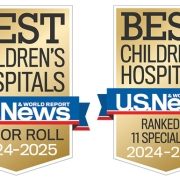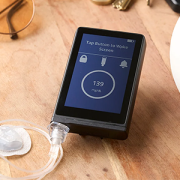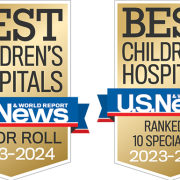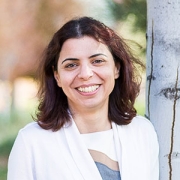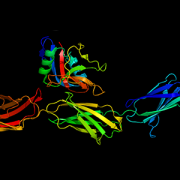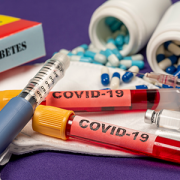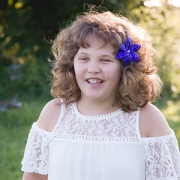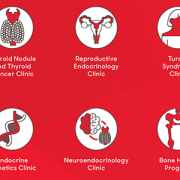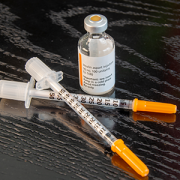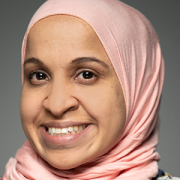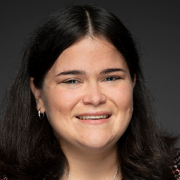Tag Archive for: endocrinology
Children’s National again ranked among the best in the nation by U.S. News & World Report
 Children’s National Hospital in Washington, D.C., was ranked as a top hospital in the nation by the U.S. News & World Report 2024-25 Best Children’s Hospitals annual rankings. This marks the eighth straight year Children’s National has made the Honor Roll list. The Honor Roll is a distinction awarded to only 10 children’s hospitals nationwide.
Children’s National Hospital in Washington, D.C., was ranked as a top hospital in the nation by the U.S. News & World Report 2024-25 Best Children’s Hospitals annual rankings. This marks the eighth straight year Children’s National has made the Honor Roll list. The Honor Roll is a distinction awarded to only 10 children’s hospitals nationwide.
This year, U.S. News ended ordinal rankings on its Honor Roll. Instead of assigning a numerical rank from 1 to 10, all hospitals on the Honor Roll will be recognized as having attained the highest standards of care in the nation.
In addition, Children’s National tied for #1 pediatric hospital in the Mid-Atlantic region, which includes New York, New Jersey, Delaware, Pennsylvania, the District of Columbia, West Virginia and Virginia. It’s also best in the Mid-Atlantic in Neonatology.
For the fourteenth straight year, Children’s National ranked in 10 specialty services. New this year, U.S. News included behavioral health as a service line in the rankings. Since it’s the first year, there are no ordinal rankings for behavioral health, but the Children’s National program was named one of the top 50 programs in the country.
“In my first year here, I witnessed what makes Children’s National so special — our commitment to collaboration, empowering one another, and charting a bold path forward for pediatric care,” said Michelle Riley-Brown, MHA, FACHE, president and chief executive officer of Children’s National. “I’m proud U.S. News again recognized Children’s National as one of the top in the nation and the highest-ranked pediatric hospital in D.C., Maryland and Virginia. Together, we’ll continue to push the boundaries of care, research and innovation to make a difference for those who matter most — the kids.”
The annual rankings are the most comprehensive source of quality-related information on U.S. pediatric hospitals and recognizes the nation’s top 50 pediatric hospitals based on a scoring system developed by U.S. News.
“For nearly two decades, U.S. News has published Best Children’s Hospitals to empower the parents and caregivers of children with complex medical needs,” said Ben Harder, chief of health analysis and managing editor at U.S. News. “Children’s hospitals appearing on the U.S. News Honor Roll have a track record of delivering unparalleled specialized care.”
The bulk of the score for each specialty service is based on quality and outcomes data. The process includes a survey of relevant specialists across the country, who are asked to list hospitals they believe provide the best care for patients with the most complex conditions.
The Children’s National specialty services that U.S. News ranked in the top 10 nationally are:
- Neonatology (No. 2), led by Billie Lou Short, M.D.
- Neurology and Neurosurgery (No. 5), led by William D. Gaillard, M.D., and Robert F. Keating, M.D.
- Cancer (No. 5), led by Eugene Hwang, M.D.
- Diabetes and Endocrinology (No. 7), led by Andrew Dauber, M.D., MMSc.
- Gastroenterology and GI surgery (No. 8), led by Ian Leibowitz, M.D., Marc Levitt, M.D., Anthony Sandler, M.D., and Timothy Kane, M.D.
- Nephrology (No. 8), led by Marva Moxey-Mims, M.D.
- Orthopedics (No. 9), led by Matthew Oetgen, M.D., M.B.A.
The other four specialties ranked among the top 50 are Behavioral Health, Cardiology and Heart Surgery, Pulmonology and Lung Surgery, and Urology.
Empowering Type 1 diabetes management with new technology
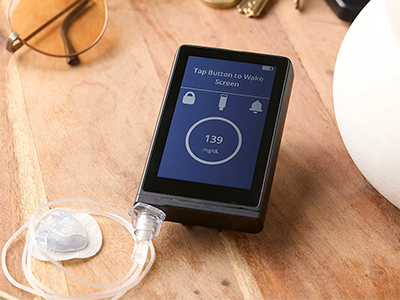
The iLet Bionic Pancreas was recently cleared by the U.S. Food and Drug Administration (FDA) and is now commercially available.
In 2021, Children’s National Hospital participated in a multi-center clinical trial to test the efficacy of the iLet Bionic Pancreas — a device that automatically regulates blood sugar levels in patients with Type 1 diabetes. The iLet Bionic Pancreas was recently cleared by the U.S. Food and Drug Administration (FDA) and is now commercially available.
“The bionic pancreas serves as an additional resource empowering patients to effectively manage their Type 1 diabetes with confidence,” says Fran Cogen, M.D., CDCES, director emerita of the Childhood and Adolescent Diabetes Program at Children’s National. “It requires minimal input from the patient.”
During initialization of the pump, patients will no longer need to enter carbohydrate amounts, just their weight. After the patient indicates whether they are having a usual meal, smaller than usual meal, or larger than usual meal, the device’s algorithms will adjust insulin doses automatically.
“Patients will not need to add correction insulin,” says Dr. Cogen. “There are 3 algorithms – one to adjust background insulin, one to adjust insulin needed to cover carbohydrates and one to adjust insulin needed to correct high blood sugars. The background insulin dosing will also be adjusted if the blood sugars decrease or become low.”
The FDA approved the iLet Bionic Pancreas for patients 6 years and older with Type 1 diabetes. Users will be required to pair the pump with a continuous glucose monitor as the pump is dependent on the monitor’s information. The results of the trial, primarily funded by the National Institute of Diabetes and Digestive and Kidney Diseases (NIDDK), part of the National Institutes of Health, were published in the New England Journal of Medicine.
Shaping the future of pediatric endocrinology
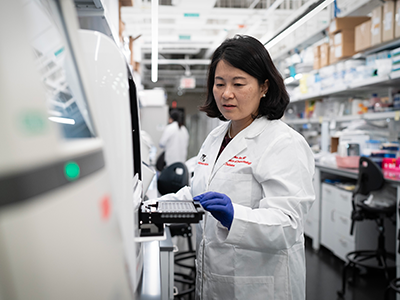
“Select patients will have the opportunity to participate in research studies focused on cutting-edge genomic investigations into their growth disorders,” says Youn Hee Jee, M.D., M.Med., endocrinologist.
“We’re dedicated to unraveling the mysteries that families have long sought answers to,” says Andrew Dauber, M.M.Sc., M.D., chief of Endocrinology at Children’s National Hospital. “There are numerous endocrine and genetic conditions with the potential to impact a child’s growth. That’s why we’ve assembled a team of leading endocrinologists and geneticists to create a new Growth Specialty Clinic and address these issues with a fresh perspective.”
This team, combined with the expertise of the hospital’s translational scientists, is making significant progress in identifying the causes of a variety of growth disorders and developing innovative treatments. And at the core of this work, Dr. Dauber says, is a recognition of the unique impact endocrine disorders have on each individual child.
What’s unique
Leveraging the expertise of Medical Geneticists Natasha Shur, M.D., and Deepika Burkardt, D.O., from the Children’s National Rare Disease Institute – the largest clinical genetics program in the United States – the growth clinic taps into substantial knowledge in the genetics of growth.
Dr. Shur emphasizes the commitment to providing answers for these families. “This collaborative effort goes beyond diagnosis; it opens doors to potential treatment options.”
The Growth Specialty Clinic is for children with severe undiagnosed growth disorders that are suspected to have a genetic etiology and children with rare genetic diagnoses who would benefit from the expertise of practitioners more familiar with those disorders. It is also closely linked to the Center for Genetic Medicine Research.
“Select patients will have the opportunity to participate in research studies focused on cutting-edge genomic investigations into their growth disorders,” says Youn Hee Jee, M.D., M.Med., endocrinologist.
In one case, Dr. Jee identified a new genetic cause of an overgrowth syndrome. Rare genetic conditions known as generalized overgrowth syndromes manifest as excessive body growth during fetal life and/or childhood, frequently resulting in tall stature. She is investigating the mechanisms that promote healthy bone growth.
Additionally, Dr. Jee identified a new genetic cause of short stature. Her research showed that the identified genetic cause impairs the recycling of essential proteins for growth, expanding our knowledge of human growth.
Moving the field forward
“We’re taking innovative approaches to treatment by leveraging our insights into the genetic origin of each patient’s growth disorder,” says Dr. Dauber.
In the brief time since the clinic’s launch, several new diagnoses and treatment pathways have already been offered. In one single-patient study, researchers were able to successfully overcome the patient’s growth hormone resistance using a targeted approach, and the patient has shown significant catch-up growth after one year of treatment.
Children’s National is also at the forefront of other groundbreaking research, launching novel clinical trials that are advancing the field of endocrinology:
- Vosoritide clinical trial: Children’s National has the first clinical trial in the world testing Vosoritide in children with certain genetic causes of short stature. Researchers have enrolled approximately 50 subjects with exciting preliminary results for patients with Noonan syndrome, Aggrecan gene mutations and NPR2 gene mutations. All 24 hypochondroplasia patients have completed the 18-month trial. Dr. Dauber intends to present results at the 2024 American College of Medical Genetics meeting in Toronto.
- Hypochondroplasia study: Children’s National is the first site to launch BioMarin’s new natural history study for children with hypochondroplasia which will also be a lead into their future Phase 3 trial.
Read more about our advances in Diabetes & Endocrinology.
Children’s National Hospital ranked #5 in the nation on U.S. News & World Report’s Best Children’s Hospitals Honor Roll
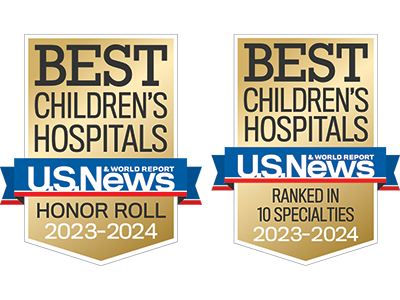 Children’s National Hospital in Washington, D.C., was ranked #5 in the nation on the U.S. News & World Report 2023-24 Best Children’s Hospitals annual rankings. This marks the seventh straight year Children’s National has made the Honor Roll list. The Honor Roll is a distinction awarded to only 10 children’s hospitals nationwide.
Children’s National Hospital in Washington, D.C., was ranked #5 in the nation on the U.S. News & World Report 2023-24 Best Children’s Hospitals annual rankings. This marks the seventh straight year Children’s National has made the Honor Roll list. The Honor Roll is a distinction awarded to only 10 children’s hospitals nationwide.
For the thirteenth straight year, Children’s National also ranked in all 10 specialty services, with eight specialties ranked in the top 10 nationally. In addition, the hospital was ranked best in the Mid-Atlantic for neonatology, cancer, neurology and neurosurgery.
“Even from a team that is now a fixture on the list of the very best children’s hospitals in the nation, these results are phenomenal,” said Kurt Newman, M.D., president and chief executive officer of Children’s National. “It takes a ton of dedication and sacrifice to provide the best care anywhere and I could not be prouder of the team. Their commitment to excellence is in their DNA and will continue long after I retire as CEO later this month.”
“Congratulations to the entire Children’s National team on these truly incredible results. They leave me further humbled by the opportunity to lead this exceptional organization and contribute to its continued success,” said Michelle Riley-Brown, MHA, FACHE, who becomes the new president and CEO of Children’s National on July 1. “I am deeply committed to fostering a culture of collaboration, empowering our talented teams and charting a bold path forward to provide best in class pediatric care. Our focus will always remain on the kids.”
“I am incredibly proud of Kurt and the entire team. These rankings help families know that when they come to Children’s National, they’re receiving the best care available in the country,” said Horacio Rozanski, chair of the board of directors of Children’s National. “I’m confident that the organization’s next leader, Michelle Riley-Brown, will continue to ensure Children’s National is always a destination for excellent care.”
The annual rankings are the most comprehensive source of quality-related information on U.S. pediatric hospitals and recognizes the nation’s top 50 pediatric hospitals based on a scoring system developed by U.S. News.
“For 17 years, U.S. News has provided information to help parents of sick children and their doctors find the best children’s hospital to treat their illness or condition,” said Ben Harder, chief of health analysis and managing editor at U.S. News. “Children’s hospitals that are on the Honor Roll transcend in providing exceptional specialized care.”
The bulk of the score for each specialty service is based on quality and outcomes data. The process includes a survey of relevant specialists across the country, who are asked to list hospitals they believe provide the best care for patients with the most complex conditions.
The eight Children’s National specialty services that U.S. News ranked in the top 10 nationally are:
- Neonatology (No. 2), led by Division Chief Billie Lou Short, M.D.
- Neurology and Neurosurgery (No. 3), led by Division Chiefs William D. Gaillard, M.D., and Robert F. Keating, M.D.
- Cancer (No. 4), led by Division Chief Jeffrey S. Dome, M.D., Ph.D.
- Nephrology (No. 6), led by Division Chief Marva Moxey-Mims, M.D.
- Orthopedics (No. 7), led by Division Chief Matthew Oetgen, M.D., M.B.A.
- Diabetes and Endocrinology (No. 7), led by Division Chief Andrew Dauber, M.D., MMSc.
- Gastroenterology and GI surgery (No. 8), led by Division Chief Ian Leibowitz, M.D.
- Pulmonology and Lung Surgery (tied for No. 9), led by Division Chief Anastassios Koumbourlis, M.D., M.P.H.
The other two specialties ranked among the top 50 were cardiology and heart surgery, and urology.
Children’s National named to U.S. News & World Report’s Best Children’s Hospitals Honor Roll
 Children’s National Hospital in Washington, D.C., was ranked No. 5 nationally in the U.S. News & World Report 2022-23 Best Children’s Hospitals annual rankings. This marks the sixth straight year Children’s National has made the list, which ranks the top 10 children’s hospitals nationwide. In addition, its neonatology program, which provides newborn intensive care, ranked No.1 among all children’s hospitals for the sixth year in a row.
Children’s National Hospital in Washington, D.C., was ranked No. 5 nationally in the U.S. News & World Report 2022-23 Best Children’s Hospitals annual rankings. This marks the sixth straight year Children’s National has made the list, which ranks the top 10 children’s hospitals nationwide. In addition, its neonatology program, which provides newborn intensive care, ranked No.1 among all children’s hospitals for the sixth year in a row.
For the twelfth straight year, Children’s National also ranked in all 10 specialty services, with seven specialties ranked in the top 10.
“In any year, it would take an incredible team to earn a number 5 in the nation ranking. This year, our team performed at the very highest levels, all while facing incredible challenges, including the ongoing pandemic, national workforce shortages and enormous stress,” said Kurt Newman, M.D., president and chief executive officer of Children’s National. “I could not be prouder of every member of our organization who maintained a commitment to our mission. Through their resilience, Children’s National continued to provide outstanding care families.”
“Choosing the right hospital for a sick child is a critical decision for many parents,” said Ben Harder, chief of health analysis and managing editor at U.S. News. “The Best Children’s Hospitals rankings spotlight hospitals that excel in specialized care.”
The annual rankings are the most comprehensive source of quality-related information on U.S. pediatric hospitals and recognizes the nation’s top 50 pediatric hospitals based on a scoring system developed by U.S. News.
The bulk of the score for each specialty service is based on quality and outcomes data. The process includes a survey of relevant specialists across the country, who are asked to list hospitals they believe provide the best care for patients with the most complex conditions.
The seven Children’s National specialty services that U.S. News ranked in the top 10 nationally are:
- Neonatology (No. 1), led by Division Chief Billie Lou Short, M.D.
- Neurology and Neurosurgery (No. 3), led by Division Chiefs William D. Gaillard, M.D., and Robert F. Keating, M.D.
- Nephrology (No. 5), led by Division Chief Marva Moxey-Mims, M.D.
- Cancer (No. 6), led by Division Chief Jeffrey S. Dome, M.D., Ph.D.
- Orthopedics (No. 7), led by Division Chief Matthew Oetgen, M.D., M.B.A.
- Pulmonology and Lung Surgery (Tied for No. 8), led by Division Chief Anastassios Koumbourlis, M.D., M.P.H.
- Diabetes and Endocrinology (No. 8), led by Division Chief Andrew Dauber, M.D., MMSc.
The other three specialties ranked among the top 50 were cardiology and heart surgery, gastroenterology and gastro-intestinal surgery, and urology.
New research on genetic evaluation of short stature, discussed by Andrew Dauber, M.D., M.M.Sc.

In this study, the authors at Shanghai Children’s Medical Center utilized next-generation sequencing (NGS) to analyze the data of patients with short stature to better understand the etiologies of short stature.
Andrew Dauber, M.D., M.M.Sc., division chief of Endocrinology at Children’s National Hospital, shared expert commentary on a recent study published in The Journal of Clinical Endocrinology & Metabolism that explores associated risk factors of short stature as identified by exome sequencing in children.
In this study, the authors at Shanghai Children’s Medical Center utilized next-generation sequencing (NGS) to analyze the data of patients with short stature to better understand the etiologies of short stature.
The big picture
“This was a large-scale study looking at 814 children with short stature and at least one more clinical feature suggestive of a genetic condition who underwent comprehensive genetic testing at Shanghai Children’s Medical Center,” explains Dr. Dauber. In this study, the authors identified a potential genetic etiology in 361 of the patients, which is 44% of the cohort.
“It is important to note that the yield of genetic testing was highly variable depending on the clinical presentation of the child,” said Dr. Dauber. “For example, patients with associated congenital anomalies or a suspected skeletal dysplasia had a diagnostic yield of 56% and 65% respectively, while patients with isolated severe short stature (defined as a height below -3 SDS) only had a yield of 11%.”
Dr. Dauber noted that the overall high yield is reflective of the types of patients who are referred to this specialty center, and the expected yield in a more general pediatric setting is likely much lower.
The patient benefit
“This study helps shed light on the prevalence of those patients in a large cohort of children presenting for evaluation of short stature,” shared Dr. Dauber. “I am hopeful that targeted treatments will improve growth in these children.”
While this study provides new insights into the underlying causes behind short stature in patients with differing phenotypes, the authors indicate that additional large-scale studies on short stature exome sequencing are warranted.
Moving the field forward
Dr. Dauber also pointed to the fact that the authors note a large number of the patients in this study had undiagnosed Rasopathies, such as Noonan syndrome. “There were also 31 patients with FGFR3 mutations, 6 patients found with ACAN (Aggrecan) mutations and 2 with NPR2 mutations,” said Dr. Dauber.
“At Children’s National, we are currently conducting a clinical trial of vosoritide, a novel growth promoting agent which targets the growth plate in children with selected genetic conditions including Noonan syndrome and patients with mutations in FGFR3, ACAN, and NPR2,” included Dr. Dauber. Preliminary results from this clinical trial were recently presented by Dr. Dauber at the Pediatric Endocrine Society annual meeting.
You can read the full study Clinical Profiles and Genetic Spectra of 814 Chinese Children With Short Stature in The Journal of Clinical Endocrinology & Metabolism.
Shideh Majidi, M.D., M.S.C.S, brings focus on psychosocial research in diabetes patients to Children’s National

Dr. Majidi specializes in Type 1 diabetes and has been involved in innovative research studying behavioral and psychosocial aspects of health care such as anxiety, depression and suicide and improving high-risk patient management for children with the disease.
Children’s National Hospital welcomes Shideh Majidi, M.D., M.S.C.S., as the new associate director of the Childhood and Adolescent Diabetes Program. Dr. Majidi specializes in Type 1 diabetes and has been involved in innovative research studying behavioral and psychosocial aspects of health care such as anxiety, depression and suicide and improving high-risk patient management for children with the disease.
Dr. Majidi comes to Children’s National from the Barbara Davis Center for Diabetes where, in addition to providing clinical care in the Pediatric Diabetes Division, she was the assistant professor of pediatric endocrinology, head of the depression screening and high-risk task force committees, developer and director of an online class for children managing their Type 1 diabetes and a member of several committees focusing on program evaluation and residency and fellowship recruitment.
When Andrew Dauber, M.D., M.M.Sc., took over the role of division chief of Endocrinology, his goal was to create a clinical endocrinology research program to provide cutting-edge treatment for families. Dr. Dauber is excited to have Dr. Majidi bring her expertise to the team to further this goal. “Dr. Majidi has played a key role in national cooperative research on quality improvement in pediatric diabetes care and is now leading an international collaborative focused on preventing suicide in individuals with Type 1 diabetes,” says Dr. Dauber. “Her compassion, intellect and commitment to improving care for all children with diabetes is an inspiration to us all.”
Dr. Majidi will continue to serve in her roles as site co-lead for Type 1 Diabetes Exchange Quality Improvement Collaborative, where she recently led a 2021 study exploring inequities in access to and outcomes of health care for those with Type 1 diabetes, and co-chair for RESCUE, which aims to reduce suicide rates among individuals with diabetes.
She is dedicated to meeting patients and families where they are to help provide the best care. “We may think we see a lack of effort in diabetes care from patients and families, but we need to reframe our mindset and dig deeper to determine what barriers are in the way of diabetes management– behavioral, psychosocial or otherwise,” says Dr. Majidi. “When we do this, we can then work on how to help families manage and overcome the barriers that affect their diabetes care.”
Two new papers advance aggrecan deficiency research
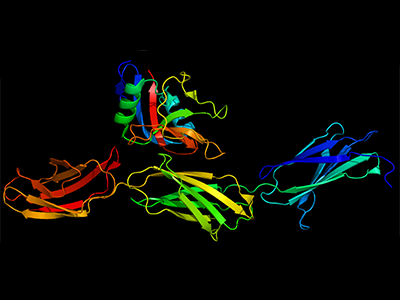
Aggrecan (ACAN) is a large protein found in joint cartilage and growth plates.
Andrew Dauber, M.D., M.M.Sc., division chief of Endocrinology at Children’s National Hospital, and colleagues recently published two papers that describe the phenotypic spectrum of aggrecan deficiency and look at treating the condition with human growth hormone.
Aggrecan (ACAN) is a large protein found in joint cartilage and growth plates. It allows joints to move smoothly and without pain. Aggrecan deficiency — due to heterozygous mutations in the ACAN gene — causes dominantly inherited short stature and, in many patients, early-onset osteoarthritis and degenerative disc disease.
Clinical phenotype of patients with aggrecan deficiency
In 2017, Dr. Dauber led an international consortium of researchers that published a manuscript describing the phenotypic spectrum of 103 individuals – 70 adults and 33 children, including 57 females and 46 males – from 20 families with ACAN mutations. In the study, Dr. Dauber and his colleagues established that short stature and accelerated bone age is common among people with ACAN mutations.
In a new study published in the American Journal of Medical Genetics Part A, Dr. Dauber and colleagues further characterize the phenotypic spectrum of aggrecan deficiency, with an emphasis on musculoskeletal health.
Twenty-two individuals from nine families were enrolled in the study. Recorded histories and examinations focused on joint health, gait analysis, joint specific patient reported outcomes and imaging.
“We performed a detailed analysis of the musculoskeletal manifestations in patients with mutations in the aggrecan gene,” says Dr. Dauber. “We found that patients with mutations in this gene had significant short stature which worsened with age. There was a high prevalence of joint complaints and arthritis in adults, and we were able to detect pre-symptomatic joint damage in children using knee MRIs.”
Treating short stature in aggrecan-deficient patients with human growth hormone
Until now, it was unknown how to treat children with aggrecan deficiency. “Providing growth hormone therapy to children with ACAN gene mutations is relatively new in the field of pediatric endocrinology,” explains Dr. Dauber. “Previously, the assumption was that this was just short stature.”
In a new study, published in The Journal of Clinical Endocrinology and Metabolism, Dr. Dauber and colleagues reported the results of a trial that evaluated the efficacy and safety of recombinant human growth hormone (rhGH) therapy on linear growth in children with ACAN deficiency.
“This is the first prospective trial of growth hormone therapy in patients with mutations in the aggrecan gene,” says Dr. Dauber. “Mutations in the gene are the cause for short stature in approximately 2% of individuals with idiopathic short stature.”
The open-label, single-arm, prospective study enrolled ten treatment-naïve patients with a confirmed heterozygous mutation in ACAN. Participants were treated with rhGH (50 µg/kg/day) over 1 year. Main outcomes measured were height velocity and change in height standard deviation score.
The authors found that growth hormone led to short term improvements in growth rate over the course of the year. The treated patients had their growth rate increase from 5.2 centimeters per year to 8.3 centimeters per year while on therapy.
In 2019, the researchers received the 2019 Human Growth Award at the Pediatric Endocrine Society’s Annual Meeting for an abstract related to this work, entitled “Clinical Characterization and Trial of Growth Hormone in Patients with Aggrecan Deficiency: 6 Month Data.”
Continuing medical education through online games
 Andrew Dauber, M.D., MMSc., chief of Endocrinology at Children’s National Hospital, participated as the faculty chair of a Med Games CME educational online activity, to provide continuing medical education for physicians. This game-based activity is intended to meet the educational needs of endocrinologists, endocrine fellows, primary care physicians, physician assistants, nurse practitioners and health care professionals who diagnose and manage children with growth hormone deficiency (CGHD). This CME educational program is provided by Med Learning Group and supported by an educational grant from Novo Nordisk Inc.
Andrew Dauber, M.D., MMSc., chief of Endocrinology at Children’s National Hospital, participated as the faculty chair of a Med Games CME educational online activity, to provide continuing medical education for physicians. This game-based activity is intended to meet the educational needs of endocrinologists, endocrine fellows, primary care physicians, physician assistants, nurse practitioners and health care professionals who diagnose and manage children with growth hormone deficiency (CGHD). This CME educational program is provided by Med Learning Group and supported by an educational grant from Novo Nordisk Inc.
Learn more about the program and test your knowledge: ‘Accurate Diagnosis and Effective Management of Children with Growth Hormone Deficiency: What Can You Do to Improve Patient Outcomes in Your Clinical Practice?’
For fifth year in a row, Children’s National Hospital nationally ranked a top 10 children’s hospital

Children’s National Hospital in Washington, D.C., was ranked in the top 10 nationally in the U.S. News & World Report 2021-22 Best Children’s Hospitals annual rankings. This marks the fifth straight year Children’s National has made the Honor Roll list, which ranks the top 10 children’s hospitals nationwide. In addition, its neonatology program, which provides newborn intensive care, ranked No.1 among all children’s hospitals for the fifth year in a row.
For the eleventh straight year, Children’s National also ranked in all 10 specialty services, with seven specialties ranked in the top 10.
“It is always spectacular to be named one of the nation’s best children’s hospitals, but this year more than ever,” says Kurt Newman, M.D., president and CEO of Children’s National. “Every member of our organization helped us achieve this level of excellence, and they did it while sacrificing so much in order to help our country respond to and recover from the COVID-19 pandemic.”
“When choosing a hospital for a sick child, many parents want specialized expertise, convenience and caring medical professionals,” said Ben Harder, chief of health analysis and managing editor at U.S. News. “The Best Children’s Hospitals rankings have always highlighted hospitals that excel in specialized care. As the pandemic continues to affect travel, finding high-quality care close to home has never been more important.”
The annual rankings are the most comprehensive source of quality-related information on U.S. pediatric hospitals. The rankings recognize the nation’s top 50 pediatric hospitals based on a scoring system developed by U.S. News. The top 10 scorers are awarded a distinction called the Honor Roll.
The bulk of the score for each specialty service is based on quality and outcomes data. The process includes a survey of relevant specialists across the country, who are asked to list hospitals they believe provide the best care for patients with the most complex conditions.
Below are links to the seven Children’s National specialty services that U.S. News ranked in the top 10 nationally:
- Neonatology (No. 1), led by Division Chief Billie Lou Short, M.D.
- Neurology and Neurosurgery (No. 3 (No. 3 nationally, the best in the Mid-Atlantic region), led by Division Chiefs William D. Gaillard, M.D., and Robert F. Keating, M.D.
- Cancer (No. 5), led by Division Chief Jeffrey S. Dome, M.D., Ph.D.
- Nephrology (No. 6), led by Division Chief Marva Moxey-Mims, M.D.
- Orthopedics (No. 6), led by Division Chief Matthew Oetgen, M.D., M.B.A.
- Pulmonology and Lung Surgery (No. 8), led by Division Chief Anastassios Koumbourlis, M.D., M.P.H.
- Diabetes and Endocrinology (No. 10), led by Division Chief Andrew Dauber, M.D., MMSc.
The other three specialties ranked among the top 50 were cardiology and heart surgery, gastroenterology and gastro-intestinal surgery, and urology.
Study examines severity of COVID-19 on kids with Type 1 diabetes
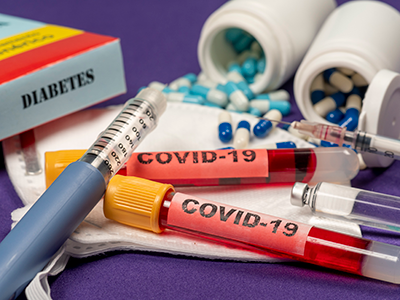
A new study published in the Journal of Diabetes, found that although nearly 80% of youth with Type 1 diabetes and COVID-19 infection are managed at home, youth from racial and ethnic minority groups – those with higher hemoglobin A1c values – and those with public insurance are at increased risk for hospitalization.
In a new study published in the Journal of Diabetes, researchers found that although nearly 80% of youth with Type 1 diabetes (T1D) and COVID-19 infection are managed at home, youth from racial and ethnic minority groups – those with higher hemoglobin A1c values – and those with public insurance are at increased risk for hospitalization. Most hospitalizations among these youth were related to diabetic ketoacidosis (DKA) (72%) and 86% of youth hospitalized had an A1c value over 9%. The increased risk for DKA among racial and ethnic minority groups and publicly insured youth in this study is indicative of disparities in T1D outcomes and aligns with other research findings both before and during the pandemic.
Adults with certain underlying medical conditions, like diabetes, are at an increased risk for severe illness from COVID-19. Though there are limited data on youth with T1D who have been infected with COVID-19, viral infections can make it harder to control blood glucose levels. If not properly managed, infections may lead to DKA, a serious life-threatening condition where the body converts fat instead of sugar into energy, causing ketones to build up in the blood and acid levels to rise.
“There is still more to learn about COVID-19 and how it affects children with diabetes and other underlying medical conditions,” said Brynn Marks, M.D., MS-HPEd, pediatric endocrinologist at Children’s National Hospital and one of the study’s co-authors. “We are hopeful that this latest data will emphasize the importance of optimizing glycemic control and give physicians and families more information about the virus and T1D so that severe illness and hospitalizations can possibly be prevented.”
In April 2020, the T1D Exchange Quality Improvement Collaborative, along with endocrinology clinics across the U.S., formed a COVID-19 clinical registry to better understand symptoms and outcomes of patients with T1D who also tested positive for SARS-CoV-2 infection. More than 46 centers nationwide, including Children’s National Hospital, submitted data to this novel registry of 266 youth under the age of 19 with previously established T1D and laboratory confirmed COVID-19.
The study found that nearly 80% of youth with T1D and known COVID-19 infection were cared for at home without any adverse outcomes. It is also important to note that COVID-19 was incidentally discovered in 16% of hospitalized youth admitted for reasons unrelated to COVID-19 or T1D (e.g. urological procedures, psychiatric admissions). However, the data revealed a disproportionate rate of hospitalizations and DKA among racial and ethnic minority groups, children who were publicly insured and those with higher A1c. Out of the 266 patients, 72% of the 61 patients were hospitalized due to DKA. An overwhelming majority (82%) of hospitalized patients had an A1c value greater than 9%. More than 40% of non-Hispanic Black youth in the study were hospitalized as compared to 14% of non-Hispanic white youth. Researchers also noted that those patients with public insurance were less likely to use insulin pumps and continuous glucose monitors, emphasizing the continued need to improve more access to diabetes technologies.
“Diabetes technology has advanced rapidly in the last decade and access to insulin pumps and continuous glucose monitors is improving, however these technological advances are perpetuating pre-existing disparities in T1D care and outcomes,” Dr. Marks said. “The data is clear and there is a pressing need to act to promote optimal care for all people with T1D.”
Recently, Dr. Marks and the Children’s National Diabetes team became official members of the Type 1 Diabetes Exchange Collaborative. The team looks forward to using the opportunity to improve diabetes care both here at Children’s National and across the country.
Raising awareness about Turner Syndrome
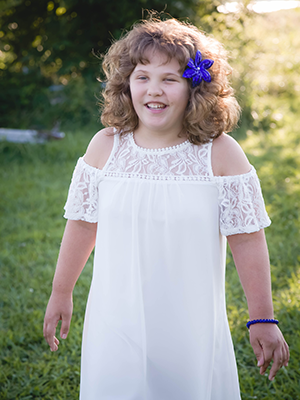
Gracie Popielarcheck was diagnosed at age one with Turner Syndrome.
By Roopa Kanakatti Shankar, M.D., M.S., Director of the Turner Syndrome Program at Children’s National Hospital.
The Children’s National Turner Syndrome Clinic is part of the Division of Endocrinology and Diabetes which is ranked by U.S. News & World Report as one of the top 10 programs in the nation. The clinic opened in January 2019 and is the first of its kind in the Washington, D.C., region. A multidisciplinary clinic is held once a month with a team experts in cardiology, endocrinology, psychology, gynecology and genetics to help care for the needs of patients with Turner Syndrome all in one day. The referral network of specialties includes neuropsychology, otolaryngology, audiology, orthopedics, urology and dentistry.
Turner syndrome (TS) is a rare disease affecting girls, with a prevalence of around 25-50 out of every 100,000 females. It is caused by partial or complete loss of the second sex chromosome. This affects multiple organs and can cause heart defects, skeletal abnormalities, hearing loss and learning difficulties. It also affects growth and puberty and can cause infertility. Although the condition was first described in 1938 by Henry Turner, an endocrinologist from Oklahoma, and is well characterized, there is a significant delay in diagnosis and recognition of the condition, especially in milder forms that can still significantly impact the well-being of the individual.
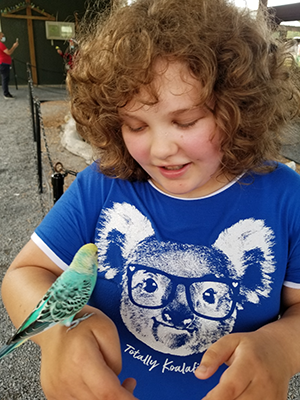
“Having a Turner Syndrome clinic near our city has made life so much easier,” says Gracie’s mom, Leslie Popielarcheck. “We can see all of Gracie’s specialists all in one day and under one roof.”
Families often ask why it took so long to recognize this condition. Many findings can be subtle, the presentation can vary greatly and often short stature may be overlooked in some girls. We now recognize that the classic form (monosomy X) impacts less than half of the girls and the rest have mosaicism (45,X/ 46XX) or other structural abnormalities in the X-chromosome. Recognizing features beyond the classic “short stature, neck webbing, lymphedema and cardiac defects” is indeed important to get timely care for these girls and women across the lifespan. Many have recurrent ear infections and hearing loss. Most have a normal intelligence, and even superior verbal skills but face challenges in visual spatial perception, executive function, working memory and social cognition that impact academic achievement.
13-year-old Gracie Popielarcheck was diagnosed with TS at the age of one after her parents noticed a delay in her speech and development. “We had never heard of Turner Syndrome when Gracie was diagnosed,” says Leslie Popielarcheck, Gracie’s mom. “Gracie didn’t have the classic physical features that girls with Turner Syndrome are known to have.”
With support, most of these girls and women can manage the medical and psychosocial challenges and rise to their full potential. Advances in the field and multidisciplinary care models have helped in the establishment of TS clinics across the country that strive to improve the standard care for these girls.
However, several challenges remain:
- Improving awareness among primary care physicians in regard to the extended spectrum and variability of presentation at a wide variety of ages
- Decreasing health disparities and making multidisciplinary clinics and comprehensive care available and accessible even to disadvantaged communities
- Ensuring adequate medical and social support for transition of young adults and care of adults with Turner syndrome
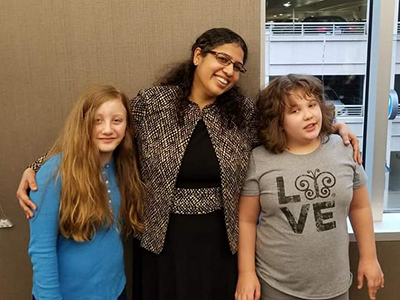
Kyra Dorfman, Dr. Shankar and Gracie.
Our TS program, initiated 2 years ago, aims to overcome these challenges and provide care to families impacted by TS in our community. We strive to serve as a Regional Resource for the community as well as physicians in our community and have been recognized by the TSGA (Turner syndrome Global Alliance) as one of only nine clinics nationwide with a Level 4 designation.
“Having a Turner Syndrome clinic near our city has made life so much easier,” Popielarcheck says. “We can see all of Gracie’s specialists all in one day and under one roof.”
As we highlight these resources for the Turner Syndrome Awareness Month this February 2021, and celebrate the strength and tenacity of our beautiful girls, we hope our efforts will improve recognition of the condition and delivery of comprehensive medical care and support to the community we serve.
There’s still more to learn about COVID-19 and diabetes

Researchers have learned a lot about COVID-19 over the past year and are continuing to learn and study more about this infection caused by the SARS-CoV-2 virus. There have been many questions about whether COVID-19 affects people with diabetes differently than those without and why this might occur.
Diabetes experts, like Brynn Marks, M.D., M.S.H.P.Ed., endocrinologist at Children’s National Hospital, have been studying the relationship between COVID-19 and diabetes, especially in the pediatric population. Dr. Marks tells us more about what we know so far and further research that needs to be done when it comes to COVID-19 and diabetes.
1. What do we know about COVID-19 and its effect on people with known diabetes?
The Centers for Disease Control and Prevention (CDC) currently lists type 2 diabetes (T2D) as a high risk condition for severe illness related to COVID-19 infection, while stating that adults with type 1 diabetes (T1D) might be at increased risk. A recent study from Vanderbilt University found that people with T1D and T2D were at approximately equal risk for complications of COVID-19 infection. As compared to adults without diabetes, adults with T1D and T2D were 3-4 times more likely to be hospitalized and to have greater illness severity. Given these comparable risks, both the American Diabetes Association and the Juvenile Diabetes Research Foundation are lobbying for adults with T1D to be given the same level or priority for COVID-19 vaccines as adults with T2D.
However, as pediatricians, we all know to be wary of extrapolating adult data to pediatrics. Children are less likely to be infected with COVID-19 and if they are, the clinical course is typically mild. To date, there have not been any studies of the impact of COVID-19 on youth with known T2D. Our clinical experience at Children’s National Hospital and reports from international multicenter studies indicate that youth with T1D are not at increased risk for hospitalization from COVID-19 infection. However, paralleling ongoing disparities in T1D care, African Americans with known T1D and COVID-19 infection were more likely to be develop diabetic ketoacidosis (DKA) than their White counterparts.
With the increased use of diabetes technologies, including continuous glucose monitors, insulin pumps and automated insulin delivery systems, diabetes care lends itself well to telemedicine. Studies from Italy during the period of lockdown showed better glycemic control among youth with T1D. Further studies are needed to better understand the implications of telehealth on diabetes care, particularly among those in rural areas with limited access to care.
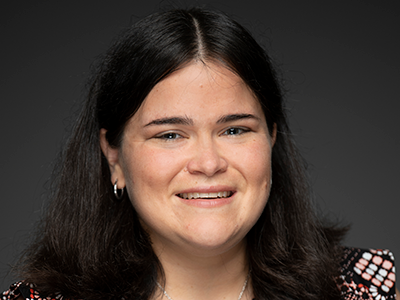
Diabetes experts, like Brynn Marks, M.D., M.S.H.P.Ed., endocrinologist at Children’s National Hospital, have been studying the relationship between COVID-19 and diabetes, especially in the pediatric population.
2. What do we know about the impact of the COVID-19 pandemic on children with newly diagnosed diabetes?
Nationwide studies from Italy and Germany over the first few months of the pandemic found no increase in the incidence of pediatric T1D during the COVID-19 pandemic as compared to the year before; in fact, the Italian study found that fewer children were diagnosed with T1D during the pandemic. However, many centers are seeing higher rates of DKA and more severe DKA at diagnosis during the pandemic, possibly due to decreased primary care visits and/or fears of contracting COVID-19 while seeking care.
To date, no studies have been published exploring the incidence of T2D in youth. A group from Children’s National, including myself, Myrto Flokas, M.D., Abby Meyers, M.D., and Elizabeth Estrada, M.D., from the Division of Endocrinology and Randi Streisand, Ph.D., C.D.C.E.S. and Maureen Monaghan, Ph.D., C.D.C.E.S., from the Department of Psychology and Behavioral Health, are gathering data to compare the incidence of T1D and T2D during the pandemic as compared to the year before.
3. Can COVID-19 cause diabetes to develop?
This has been area of great interest, but the jury is still out. The SARS-CoV-2 virus, which causes COVID-19 infection, binds the angiotensin-converting enzyme 2 (ACE2) receptor which is located in many tissues throughout the body, including the pancreas. SARS-CoV-2 has been shown to infect pancreatic tissue leading to impaired glucose stimulated insulin secretion. Although the SARS-CoV-2 virus could plausibly cause diabetes, assessment has been complicated by many confounders that could be contributing to hyperglycemia in addition to or rather than the virus itself. Stress-induced hyperglycemia from acute illness, the use of high dose steroids to treat COVID-19 infection, and the disproportionate rates of infection among those already at high risk for T2D, as well as weight gain due to changes in day-to-day life as a result of social distancing precautions are all likely contributing factors.
Genetics can’t explain mixed impact of growth hormone therapy

Growth hormone therapy is one of the most common treatments for short stature in children. However, endocrinologists report mixed outcomes, even when children have the same underlying condition as the cause of their short stature. Despite research into a variety of potential causes for this unpredictable response, there is still very little scientific evidence to help physicians predict whether children with short stature who are treated with growth hormone will respond to the treatment or not.
A study published in the Journal of Clinical Endocrinology and Metabolism took up this question with an eye to the genetic factors that might predict response by conducting the first ever genome-wide association study of response to growth hormone.
“Previous disease-specific models have been developed using multiple clinical variables such as parental height, age at treatment start, peak hormone levels and doses, and birth parameters, however, these clinical parameters only partially predict variation in response,” wrote the study authors, including Andrew Dauber, M.D., first author and chief of the division of Endocrinology at Children’s National Hospital. “Our goal was to perform a large-scale genome-wide study to provide a comprehensive assessment of how common genetic variation may play a role in growth hormone response.”
To accomplish this, the study combined five cohorts from across the world to identify 614 individuals for further review. All patients had short stature caused by conditions including growth hormone deficiency, small for gestational age, or idiopathic short stature (no previously identified cause), who received growth hormone as treatment.
Interestingly, the researchers found no overwhelming genetic predictors of response to growth hormone. They did identify a few signals that may potentially play a role in the body’s response to growth hormone but noted those signals will need further exploration. The study also ruled out the idea that genetic predictors of height in the general population might predict response to growth hormone.
“Identifying genetic predictors of how a child with short stature will respond to growth hormone would be an important step forward for clinicians and parents to make informed decisions about the right treatment approach,” says Dr. Dauber. “Though we didn’t find any specific indicators, this large-scale study has allowed us to rule out some previously held assumptions and offers several new avenues to explore.”
The study was conducted in collaboration with Pfizer and Boston Children’s Hospital.
Children’s National ranked a top 10 children’s hospital and No. 1 in newborn care nationally by U.S. News
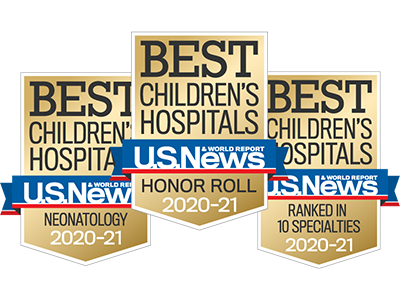
Children’s National Hospital in Washington, D.C., was ranked No. 7 nationally in the U.S. News & World Report 2020-21 Best Children’s Hospitals annual rankings. This marks the fourth straight year Children’s National has made the list, which ranks the top 10 children’s hospitals nationwide.
In addition, its neonatology program, which provides newborn intensive care, ranked No.1 among all children’s hospitals for the fourth year in a row.
For the tenth straight year, Children’s National also ranked in all 10 specialty services, with seven specialties ranked in the top 10.
“Our number one goal is to provide the best care possible to children. Being recognized by U.S. News as one of the best hospitals reflects the strength that comes from putting children and their families first, and we are truly honored,” says Kurt Newman, M.D., president and CEO of Children’s National Hospital.
“This year, the news is especially meaningful, because our teams — like those at hospitals across the country — faced enormous challenges and worked heroically through a global pandemic to deliver excellent care.”
“Even in the midst of a pandemic, children have healthcare needs ranging from routine vaccinations to life-saving surgery and chemotherapy,” said Ben Harder, managing editor and chief of Health Analysis at U.S. News. “The Best Children’s Hospitals rankings are designed to help parents find quality medical care for a sick child and inform families’ conversations with pediatricians.”
The annual rankings are the most comprehensive source of quality-related information on U.S. pediatric hospitals. The rankings recognize the nation’s top 50 pediatric hospitals based on a scoring system developed by U.S. News. The top 10 scorers are awarded a distinction called the Honor Roll.
The bulk of the score for each specialty service is based on quality and outcomes data. The process includes a survey of relevant specialists across the country, who are asked to list hospitals they believe provide the best care for patients with the most complex conditions.
Below are links to the seven Children’s National specialty services that U.S. News ranked in the top 10 nationally:
- Neonatology (No. 1), led by Division Chief Billie Lou Short, M.D.
- Neurology and Neurosurgery (No. 3), led by Division Chiefs William D. Gaillard, M.D., and Robert F. Keating, M.D.
- Cancer (No. 6), led by Division Chief Jeffrey S. Dome, M.D., Ph.D.
- Nephrology (No. 7), led by Division Chief Marva Moxey-Mims, M.D., FASN
- Orthopedics (No. 9), led by Division Chief Matthew Oetgen, M.D., MBA
- Pulmonology and Lung Surgery (No.9), led by Division Chief Anastassios Koumbourlis, M.D., MPH
- Diabetes and Endocrinology (No. 10), led by Division Chief Andrew Dauber, M.D., MMSC
The other three specialties ranked among the top 50 were cardiology and heart surgery, gastroenterology and gastro-intestinal surgery, and urology.
Diabetes clinic helps undocumented children manage their chronic condition
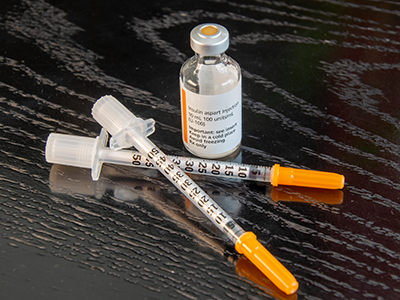
A diabetes clinic gives undocumented children with diabetes access to the care they need to maintain their health with this chronic condition.
In 2018, Jennifer Boughton, a social worker at Children’s National Hospital, came up with the idea of starting a diabetes clinic for patients whose immigration status prevented them from qualifying for insurance. The idea came about after undocumented children were arriving in the emergency department with high blood sugar and dangerously elevated ketone levels.
Through donations and the employees, who volunteer their time, Boughton’s idea became a reality. In January of 2019, the diabetes center held its first access clinic. The clinic has been open every three months since then for undocumented children with diabetes.
Flyers for the clinic are sent to local schools and organizations to help recruit patients.
In the first year, the patient volume has quadrupled and the hbA1c levels have decreased for patients who attend.
Read more about the Diabetes Access Clinic here.
Working to improve the management of endocrine related conditions
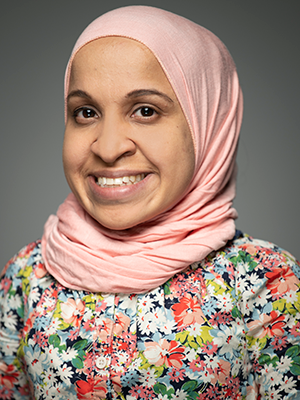
This past fall, Nadia Merchant, M.D., joined Children’s National Hospital as an endocrinologist in the Endocrinology and Diabetes Department. Dr. Merchant received her undergraduate and medical education at Weill Cornell Medical College in Qatar. She completed her pediatric residency at Wright State Boonshoft School of Medicine. She then completed her genetics residency and pediatric endocrine fellowship at Baylor College of Medicine/Texas Children’s Hospital.
Dr. Merchant was born with acromesomelic dysplasia, a rare genetic disorder, but that hasn’t stopped her from pursuing her medical career. While at Baylor College of Medicine, Dr. Merchant was very active in quality improvement projects, research and organizations that raise awareness of endocrine related conditions. For several years, she was a moderator at Baylor College of Medicine for “From Stress to Strength,” at a course for parents of children with genetic disorders and autism. Dr. Merchant also served as an endocrine fellow representative on the American Academy of Pediatrics Section on Endocrinology (SOEn) for the last two years and also served on the committee for a Bone and Mineral special interest group within the Pediatric Endocrine Society (PES). During medical school, she worked with Positive Exposure, an organization that uses visual arts to celebrate human diversity for individuals living with genetic, physical, behavioral and intellectual differences.
During the 2019 Endocrine Society Annual Meeting, Dr. Merchant won the Presidential Poster Award for her poster presentation: Assessing Metacarpal Cortical Thickness as a Tool to Evaluate Bone Density Compared to DXA in Osteogenesis Imperfecta a research project assessing whether hand film is an additional tool to detect low bone mineral density in children.
Dr. Nadia Merchant is currently one of the endocrinologists in the multidisciplinary bone health clinic at Children’s National, a clinic dedicated to addressing and improving bone health in children. Dr. Merchant also manages endocrine manifestations in children with rare genetic disorders.
The Endocrinology department at Children’s National is ranked among the best in the nation by “U.S. News & World Report”.
Bringing diabetes technology to patients and providers

Brynn Marks, M.D., endocrinologist at Children’s National Hospital, was diagnosed with Type 1 diabetes at the age of five years old and knows too well the struggles that may come with managing this chronic condition. After finding the right, knowledgeable provider as a teen, Dr. Marks realized that she wanted to become an endocrinologist and be that resource and support for others with Type 1.
Developments in diabetes technologies, including continuous glucose monitors (CGM) and insulin pumps, hold great promise for improving diabetes control while also improving quality of life for those living with Type 1. However, the pace of development also presents challenges for busy clinicians who must keep up with rapid developments in the field. Dr. Marks is focused on making sure patients and providers have the latest information and training on diabetes technologies with the goal that they can be more effectively used by more people in the real world.
“These diabetes technologies are very important for kids and teens with diabetes because they can help them to live life as normally as possible while affording the freedom they need to just be kids,” says Dr. Marks.
Dr. Marks’ recent research includes a study where she used an app to deliver medical education about diabetes technology. Participants received authentic, case-based scenarios focused on the technologies to help them apply knowledge of these technologies to real-world clinical scenarios involving insulin pumps and CGMs. All of the education was delivered through questions and explanations in an effort to keep the learners engaged with the curriculum. The questions were repeated over 3-4 months to improve learning and long-term knowledge retention. The study showed that knowledge and confidence about these technologies improved and ultimately led to better patient care.
Dr. Marks presented two posters at a recent International Society for Pediatric and Adolescent Diabetes (ISPAD) meeting related to her efforts to make these technologies more accessible:
Experiential Learning in T1D Technology Education: Knowledge of Parents and Clinicians: Dr. Marks enrolled different groups of learners in the diabetes technology curriculum mentioned above, including parents of children with Type 1 diabetes, attending physicians, pediatric endocrine fellows and certified diabetes educators. Results showed minimal difference among those groups in terms of knowledge about the pumps and CGMs. Interestingly, clinicians who had the opportunity to wear the technologies for educational purposes had greater knowledge than clinicians who did not have the same opportunity. Based on these results, Dr. Marks advocated that opportunities to wear pumps and CGMs should be a routine part of education for clinicians working with these technologies.
A Qualitative Analysis of Clinicians’ Experiences Wearing CGM: Dr. Marks explored the reactions of clinicians without diabetes who were given the opportunity to wear continuous glucose monitors for 1 week. Participants reported that the opportunity to wear these technologies improved their knowledge and gave them greater empathy for patients using CGM.
Dr. Marks’ work to date has identified strategies to improve knowledge about insulin pumps and CGM. Moving forward, she will continue to study the best ways to educate parents and clinicians about these diabetes technologies in hopes of improving the day to day lives of the children they care for.



